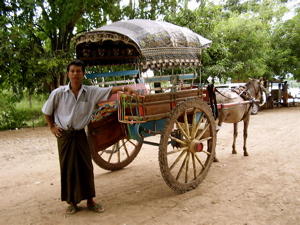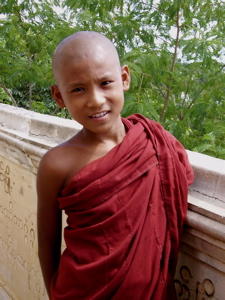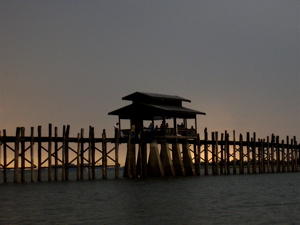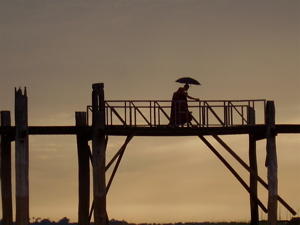I spent the last 5 days in Burma (Myanmar) visiting a friend, Natalya, who is working as a teacher in Yangon at the International School. I coordinated my visit with her fall break from school so that we would be able to travel together and I would have a more meaningful impression of the country in the short time I was able to visit. First, some of you may have guessed that this visit to Burma was a big decision for me to make. When I lived in Chiangmai in 2001 I knew some Burmese exiles who recounted stories of the reign of terror that the government in Burma directs, and as such I was wary to visit the country, not because of any danger to myself, but because I didn't want to "support" the current government by adding to its budding tourist trade. The current government is run by the military and is widely known to massacre its own citizens if they are believed to be politically opposed to the regime, and also has the largest number of child soldiers in the world in their national army. In fact, they regularly pick up street children and force them into military training "camps" where they become addicted to drugs and are forced to do things like run through mine fields and torture their fellow soldiers in the camps. The government is perhaps most well known for its 1988 massacre of around 3000 students, nurses, and other activists who took to the streets in a peaceful demonstration for democracy. Of course, none of this is at all evident to the average tourist today. Burma appears to be a calm, peaceful country with a contented population. At least in the places tourists are allowed to see. There are many areas of the country that are off limits, so it is impossible to know what conditions are like in those regions.
I was most struck by two things about Burma: (1) the lack of infrastructure and poverty is so evident that it is literally like walking into a place where development froze 100 years ago; (2) the people are incredibly warm- I have never had the experience where all I had to do was smile to bring out a huge grin and happy giggling from the people I passed. Both of these elements of Burma have a strong connection to the fact that there is still very little tourism in the country. Outside of Bagan, Natalya and I actually encountered very few travellers, westerners or other Asians. In fact, on the flight from Singapore to Yangon I did not see any other foreigners at all.
And what a first impression of Burma that flight was! We landed on the tarmac and I looked around, trying to figure out where exactly the airport was. There was a golden monstrosity of a building that looked completely empty, and otherwise some run-down old warehouse-like structures with the windows knocked out and plywood sheets nailed haphazardly to the outside. It turned out that one section of that "warehouse" was actually the airport. Not a very auspicious welcome to the nation's capitol!
The taxi that drove us into central Yangon was similarly run-down, lacking door handles and window handles, with it's steering wheel on the right side even though traffic also drove on the right in Burma. Natalya pointed out that most of the vehicles were hand-me-downs from Japan or elsewhere, and few claimed the distinction of being newer than about 50 years. In fact, cars are definitely not the primary mode of transportation in Burma. I would say most Burmese travel by bicycle, though motorbikes, horse carts, and ox carts are also common.
I spent the first night with Natalya at her apartment in Yangon, where I discovered that even though the city looks war and/or poverty-ravaged from the outside, and has extremely unreliable electricity and streets that are covered in pot holes and sewers running along the sides, it has many hidden "surprises" in the form of beauty on the inside. First, Natalya's apartment was actually quite beautiful, freshly painted, wood floors, and teak furniture. Second, we went to a restaurant called "Monsoon" that looked very unremarkable from the outside, but wow, on the inside it was a gorgeous resetaurant that served great food. Natalya said that Yangon has dozens of places like this.
Unknowing, I scheduled my visit to Burma during one of the biggest national holidays- Thadingyet- or the "Festival of Lights". When I got to Yangon many locals were lighting up the streets and pagodas with long lines of candles made with oil in little clay pots. These candles sparkled through out the city. When I continued on to Mandalay with Natalya for the next two days, the candles were joined with paper lanterns hung in front of houses, paper balloons in the air, and showers of firecrackers being set off in every direction.
We were only in Yangon briefly and spent two days each in and around Mandalay and Bagan. I am going to post some pictures from Mandalay below, and will write more about what we did in the next entry:

Typical horse-drawn carriage and driver (this man drove us around one of the old cities near Mandalay called Inwa)

This is an ancient wooden monastery at Inwa

These lions are important Burmese symbols that you see through out the country. These ones are at the base of Mandalay Hill

Monks are literally everywhere, and of all ages

This is the longest teak bridge in the world- about 1.5 km - known as U Bein's Bridge
a>

Locals commute across the bridge on foot and bike at sunrise and sunset


Picture taken from the bridge

Me in front of the Mandalay moat that surrounds the old fort
No comments:
Post a Comment